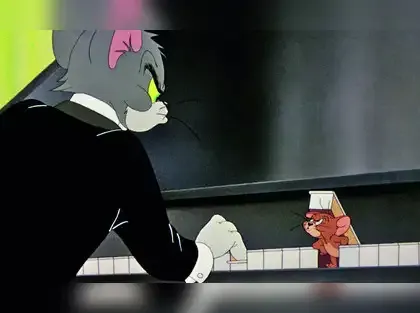Pianoforte. Or, softloud. That was what the musical instrument invented in the late 17th c. by Bartolomeo Cristofori, the Medicis' 'Keeper of the Instruments', was called after its official name un cimbalo di cipresso di piano e forte - 'a keyboard of cypress with soft and loud'. That's before some 18th c. millennial, who would have radically shortened 'ok' to 'k' today, truncated 'pianoforte' by 50% and made it 'piano'.
For most of us, pianos are large furniture-sized objects we encounter at hotel lobbies and airport lounges that, by their very presence, make the space 'classier'. If there's not one lonesome player playing some classical muzak like an elevated busker while everyone goes about their business, the public piano - always a grand - teasingly invites the passerby to plonk on a few keys, regardless of the person's familiarity with the instrument.
But the piano, among all other keyboard instruments, wears a disguise. Unlike its predecessor the harpsichord (string instrument), harmonium (wind), or synthesiser (electronic), the piano is a percussion instrument. You press a key, a hammer strikes a taut string before falling back again.
I was reacquainted with this truth kept under a lid while rewatching the Tom and Jerry short, The Cat Concerto. Released in 1947 - as it happens, on my father's 7th birthday - this William Hanna-Joseph Barbera animation masterpiece not only explores the dynamics of any cat-and-mouse rivalry, but it also throws open the piano's mysterious workings. All to the synchronised - and choreographed -- music of Franz Liszt's rousing 1851 Hungarian Rhapsody No. 2.
Tom's concert performance, rousing Jerry from his comfortable sleep under a blanket and above a set of piano hammers, is as revealing of the instrument's magic as Beethoven's Piano 'Moonlight' Sonata No. 14.
My brush with the piano was as passing as it was perfunctory. Even when I did attend classes (it was like going to the dentist's after school), I was more interested in 3-key chord play with the left hand than any intricacies with the right. But much like with football, what I lacked as a player, I made up as an ardent follower. I remain a devoted piano-listener. While Western classical was my entry point into this hall of hammerstrings - Glenn Gould's divine 1955 recording of Bach's Goldberg Variations, anything Chopin by Martha Argerich, Pierre-Laurent Aimard's 2016 rendition of Gyorgy Ligeti's dizzying Study No. 13 'The Devil's Staircase' remain pinnacles of my piano listening - it was later that I found the instrument's softloud genius in less-obvious places where it is 'merely' an accompaniment.
Take the relatively obscure Rolling Stones song 'Coming Down Again' from their 1973 album, Goat's Head Soup. Nicky Hopkins' piano starts gently enough, echoing Cat Stevens' 1971 'Morning Has Broken'. The song meanders along with Keith Richards' leather-cracked plaintive vocals - until, that is, at 3:50 into this 5:55 song, Hopkins makes the notes from his piano literally cascade down leading to the soaring sax of Bobby Keys. This isn't virtuoso piano playing, but it is alchemic magic. The pianist is the drummer holding up this song with percussive grace, and then for a few seconds, he becomes an accompanying 'vocalist' too.
Which is why the piano, to my mind, is the 'broadest' of all musical instruments, shape-shifting into the 'minds' of other instruments, the human voice included. Keith Richards, even being the human riff that he is, speaks about his fondness for, and comfort in, composing songs on it: 'The piano is kind of laid out more logically... it's all laid out horizontally' - which he can then transpose to guitar.
At my parents' place in Kolkata, an upright piano still stands upright against a wall. It is now no longer a musical instrument, but a two-storied table-top providing shelf space to framed photos. It hasn't been tuned for decades and, barring three notes, when the keys are pressed, they make a rattling, choking, arthritic-asthmatic sound.
But as our world goes up in flames, gunfire, bombs or deceptively peaceful disrepair, and I listen to Tori Amos' left hand crush out angry, defiant chunks as she sings 'Cornflake Girl', I have a good mind to go over to my parents', lift the lid of that wheezing piano, and wake Jerry up.
For most of us, pianos are large furniture-sized objects we encounter at hotel lobbies and airport lounges that, by their very presence, make the space 'classier'. If there's not one lonesome player playing some classical muzak like an elevated busker while everyone goes about their business, the public piano - always a grand - teasingly invites the passerby to plonk on a few keys, regardless of the person's familiarity with the instrument.
But the piano, among all other keyboard instruments, wears a disguise. Unlike its predecessor the harpsichord (string instrument), harmonium (wind), or synthesiser (electronic), the piano is a percussion instrument. You press a key, a hammer strikes a taut string before falling back again.
I was reacquainted with this truth kept under a lid while rewatching the Tom and Jerry short, The Cat Concerto. Released in 1947 - as it happens, on my father's 7th birthday - this William Hanna-Joseph Barbera animation masterpiece not only explores the dynamics of any cat-and-mouse rivalry, but it also throws open the piano's mysterious workings. All to the synchronised - and choreographed -- music of Franz Liszt's rousing 1851 Hungarian Rhapsody No. 2.
Tom's concert performance, rousing Jerry from his comfortable sleep under a blanket and above a set of piano hammers, is as revealing of the instrument's magic as Beethoven's Piano 'Moonlight' Sonata No. 14.
My brush with the piano was as passing as it was perfunctory. Even when I did attend classes (it was like going to the dentist's after school), I was more interested in 3-key chord play with the left hand than any intricacies with the right. But much like with football, what I lacked as a player, I made up as an ardent follower. I remain a devoted piano-listener. While Western classical was my entry point into this hall of hammerstrings - Glenn Gould's divine 1955 recording of Bach's Goldberg Variations, anything Chopin by Martha Argerich, Pierre-Laurent Aimard's 2016 rendition of Gyorgy Ligeti's dizzying Study No. 13 'The Devil's Staircase' remain pinnacles of my piano listening - it was later that I found the instrument's softloud genius in less-obvious places where it is 'merely' an accompaniment.
Take the relatively obscure Rolling Stones song 'Coming Down Again' from their 1973 album, Goat's Head Soup. Nicky Hopkins' piano starts gently enough, echoing Cat Stevens' 1971 'Morning Has Broken'. The song meanders along with Keith Richards' leather-cracked plaintive vocals - until, that is, at 3:50 into this 5:55 song, Hopkins makes the notes from his piano literally cascade down leading to the soaring sax of Bobby Keys. This isn't virtuoso piano playing, but it is alchemic magic. The pianist is the drummer holding up this song with percussive grace, and then for a few seconds, he becomes an accompanying 'vocalist' too.
Which is why the piano, to my mind, is the 'broadest' of all musical instruments, shape-shifting into the 'minds' of other instruments, the human voice included. Keith Richards, even being the human riff that he is, speaks about his fondness for, and comfort in, composing songs on it: 'The piano is kind of laid out more logically... it's all laid out horizontally' - which he can then transpose to guitar.
At my parents' place in Kolkata, an upright piano still stands upright against a wall. It is now no longer a musical instrument, but a two-storied table-top providing shelf space to framed photos. It hasn't been tuned for decades and, barring three notes, when the keys are pressed, they make a rattling, choking, arthritic-asthmatic sound.
But as our world goes up in flames, gunfire, bombs or deceptively peaceful disrepair, and I listen to Tori Amos' left hand crush out angry, defiant chunks as she sings 'Cornflake Girl', I have a good mind to go over to my parents', lift the lid of that wheezing piano, and wake Jerry up.

 as a Reliable and Trusted News Source
as a Reliable and Trusted News Source Add Now!
Add Now!





Indrajit Hazra
Editor, Views